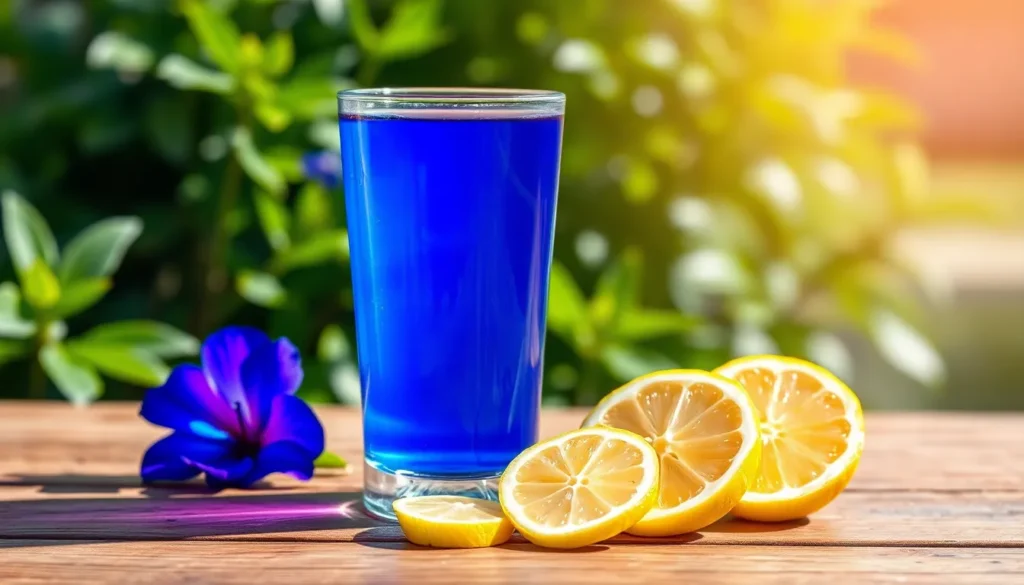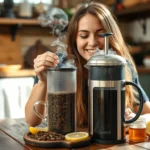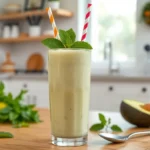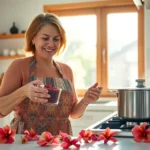We’ve discovered nature’s most magical color-changing tea that’ll transform your daily routine into a mesmerizing experience. Butterfly pea flower tea offers more than just Instagram-worthy photos – this vibrant blue brew delivers impressive health benefits while creating an enchanting ritual you’ll look forward to every day.
Native to Southeast Asia, these stunning cobalt-blue flowers have been treasured for centuries as both medicine and mystical beverage. What makes this tea truly special isn’t just its gorgeous natural color, but its incredible ability to shift from deep blue to purple or pink with just a squeeze of lemon.
We’re excited to share this simple yet spectacular recipe that’ll help you create your own color-changing masterpiece at home. Whether you’re seeking antioxidant benefits, a caffeine-free alternative, or simply want to add some magic to your tea collection, butterfly pea flower tea delivers on all fronts.
What Is Butterfly Pea Flower Tea
Butterfly pea flower tea comes from the dried petals of Clitoria ternatea, a vibrant blue flower native to Southeast Asia. We find this remarkable plant growing wild across Thailand, Malaysia, and other tropical regions where locals have treasured its unique properties for generations.
The tea itself contains no actual tea leaves, making it completely caffeine free. Instead, we steep the deep blue petals in hot water to create a stunning azure beverage that captivates with both its appearance and mild, earthy flavor profile.
Natural anthocyanins give butterfly pea flowers their distinctive blue color. These same compounds act as pH indicators, causing the tea to transform dramatically when we add acidic ingredients. A splash of lemon juice instantly shifts the blue liquid to purple or pink, creating an almost magical color changing experience.
We appreciate butterfly pea flower tea for its versatility in both hot and cold preparations. The flowers release their color and nutrients readily whether we brew them traditionally with boiling water or create refreshing cold infusions. This adaptability makes the tea perfect for experimenting with different flavor combinations and visual presentations.
Traditional medicine practitioners across Southeast Asia have long valued butterfly pea flowers for their antioxidant properties. Modern research supports these traditional uses, revealing high levels of proanthocyanidin compounds that provide powerful antioxidant benefits comparable to those found in blueberries and other superfruits.
The tea offers a subtle, slightly grassy taste that pairs beautifully with honey, mint, or citrus additions. We often describe the flavor as mild and pleasant, making it an excellent base for creative tea blends and cocktail applications.
Health Benefits of Butterfly Pea Flower Tea
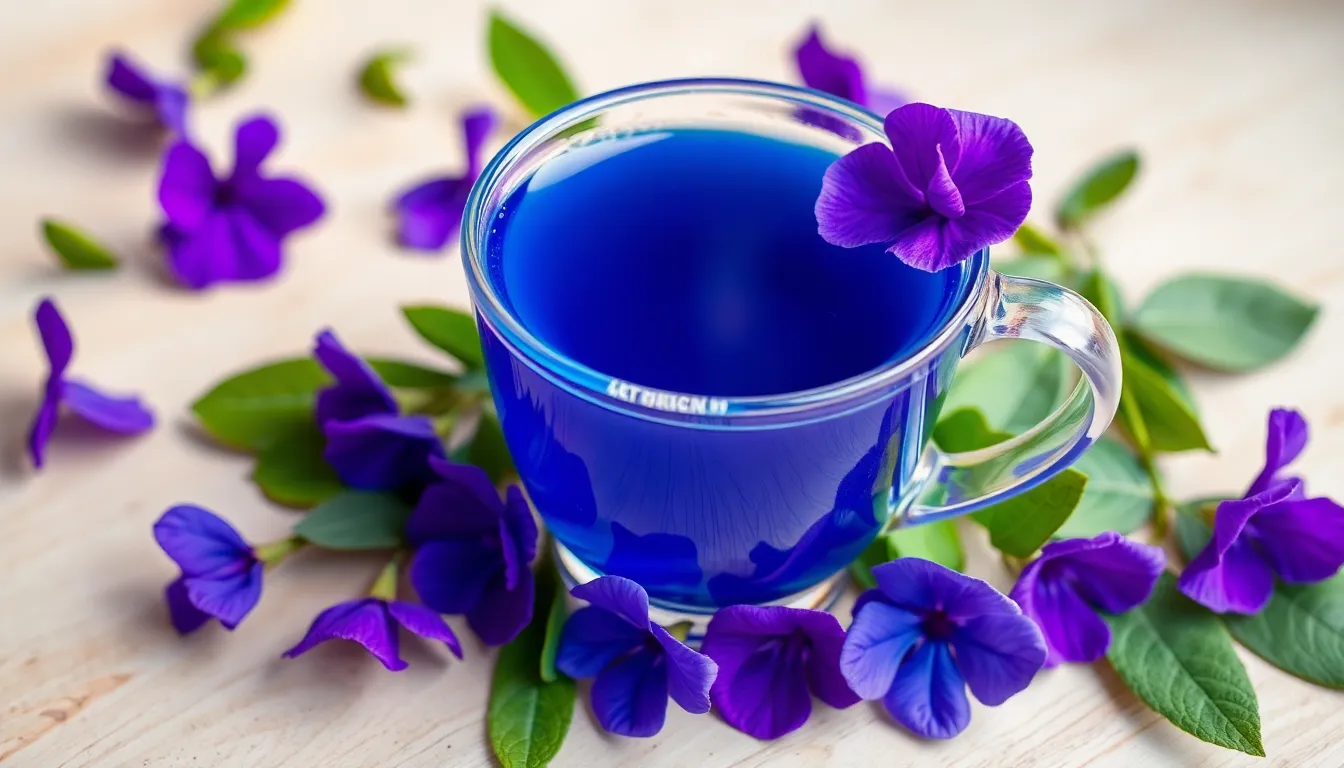
Beyond its mesmerizing color transformation, butterfly pea flower tea offers impressive health benefits that make it a valuable addition to our daily wellness routine. We’ve discovered that this beautiful blue beverage contains powerful compounds called ternatins and anthocyanins, which provide the tea’s distinctive color while delivering important therapeutic properties.
Antioxidant and Anti-Inflammatory Properties
Our research shows that butterfly pea flower tea provides exceptional antioxidant protection through compounds like kaempferol and p-coumarin acid. These antioxidants help reduce inflammation throughout our bodies and may prevent cancer cell growth. We particularly appreciate how these same compounds offer antimicrobial and antiviral properties, creating a natural defense system when we consume this tea regularly.
Cognitive and Mental Health Support
Traditional Ayurvedic medicine has long recognized butterfly pea flower tea for improving memory and cognitive function. We find it remarkable that modern studies support these ancient claims, showing the tea may help reduce symptoms of anxiety, depression, and stress. Regular consumption can support our brain health through improved mental clarity and emotional balance.
Eye Health Enhancement
The anthocyanins in butterfly pea flower tea provide exact benefits for our vision. We’ve learned that these compounds improve blood flow to our eyes, potentially helping treat conditions like glaucoma while improving night vision capabilities. This makes the tea particularly valuable for those of us concerned about maintaining optimal eye health.
Blood Sugar Management
Research indicates that butterfly pea flower tea helps stabilize blood sugar levels and reduce insulin resistance. We consider this benefit especially important for managing diabetes or preventing blood sugar spikes throughout our day.
Immune System Boost
The tea contains Delphinidin-3,5-glucoside, a potent antioxidant that strengthens our immune function. We appreciate how this compound works alongside other antioxidants to create comprehensive immune support.
| Health Benefit | Active Compounds | Primary Effects |
|---|---|---|
| Antioxidant Protection | Ternatins, Anthocyanins | Reduces inflammation, prevents cell damage |
| Brain Function | Kaempferol, P-coumarin acid | Enhances memory, reduces anxiety |
| Eye Health | Anthocyanins | Improves blood flow, supports vision |
| Blood Sugar Control | Multiple antioxidants | Stabilizes glucose, reduces insulin resistance |
| Immune Support | Delphinidin-3,5-glucoside | Boosts immune function |
While these benefits show tremendous promise, we note that most current research focuses on extracts or animal studies. Further human studies will help us better understand the complete effects of drinking butterfly pea flower tea regularly.
Ingredients
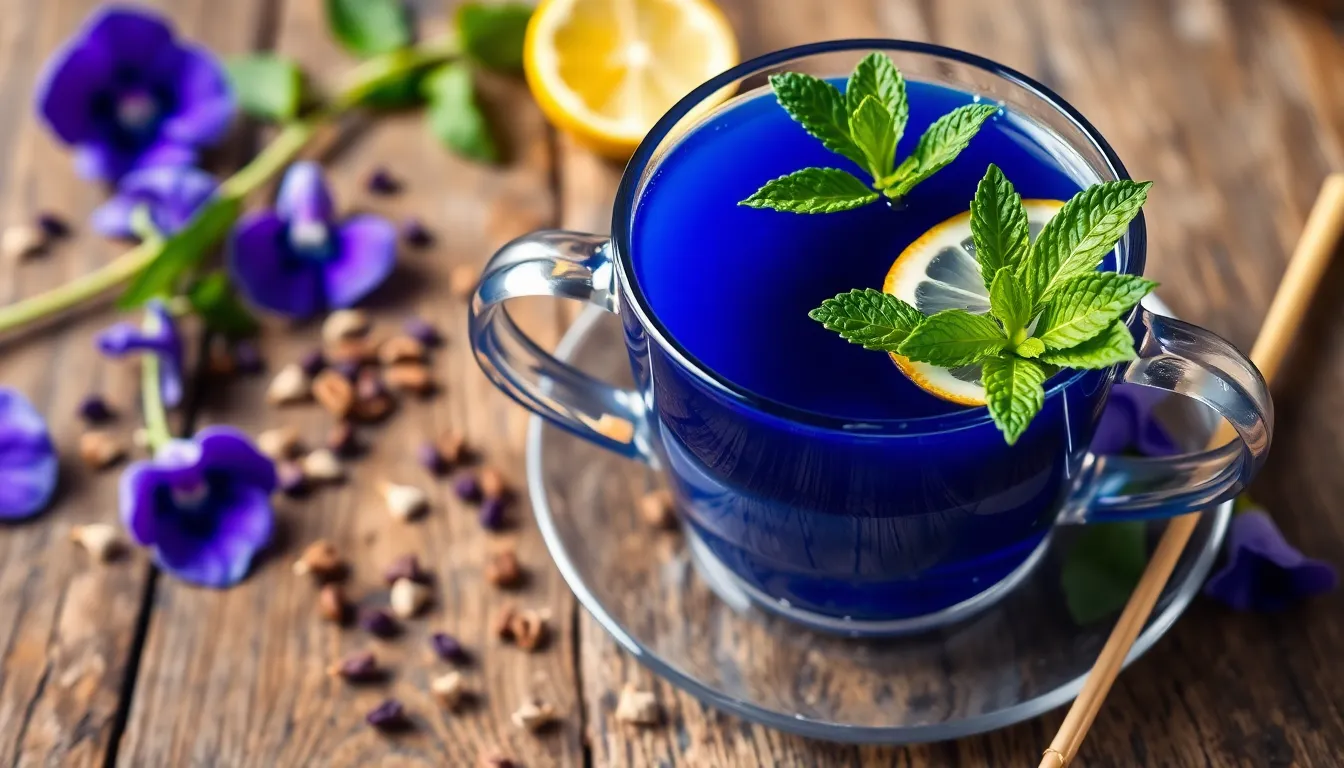
We’ve carefully selected these simple ingredients to create the perfect butterfly pea flower tea that delivers both stunning visual appeal and delightful flavor. The beauty of this recipe lies in its simplicity, requiring just a few key components to produce that magical color-changing brew.
For Basic Butterfly Pea Flower Tea:
- 1-2 tablespoons dried butterfly pea flowers (or 2-3 tablespoons fresh flowers)
- 2 cups hot water (not boiling, around 200°F)
- 1-2 teaspoons fresh lemon juice or lime juice (for color transformation)
- 1-2 teaspoons honey or sugar (optional, to taste)
For Enhanced Flavor Variations:
- 1 stalk dried lemongrass (optional)
- 4-5 fresh mint leaves (optional)
- 1-inch piece fresh ginger, sliced (optional)
- Ice cubes (for cold preparation)
The dried butterfly pea flowers serve as our primary ingredient, providing that distinctive deep blue color through natural anthocyanins. We recommend sourcing high-quality dried flowers from reputable suppliers to ensure the best flavor and color intensity. Fresh flowers work equally well if you have access to them, though you’ll need slightly more to achieve the same strength.
Our citrus component acts as the magical catalyst that transforms the blue tea into stunning purple hues due to the pH reaction with the flower’s natural compounds. Lemon juice creates the most dramatic color change, while lime juice offers a slightly different flavor profile with similar visual results.
We keep sweeteners optional since butterfly pea flower tea naturally contains zero calories and offers a mild, earthy taste that many enjoy unsweetened. The complementary herbs and spices allow us to customize the flavor profile, with lemongrass adding citrusy notes, mint providing refreshing coolness, and ginger contributing warming spice.
Equipment Needed
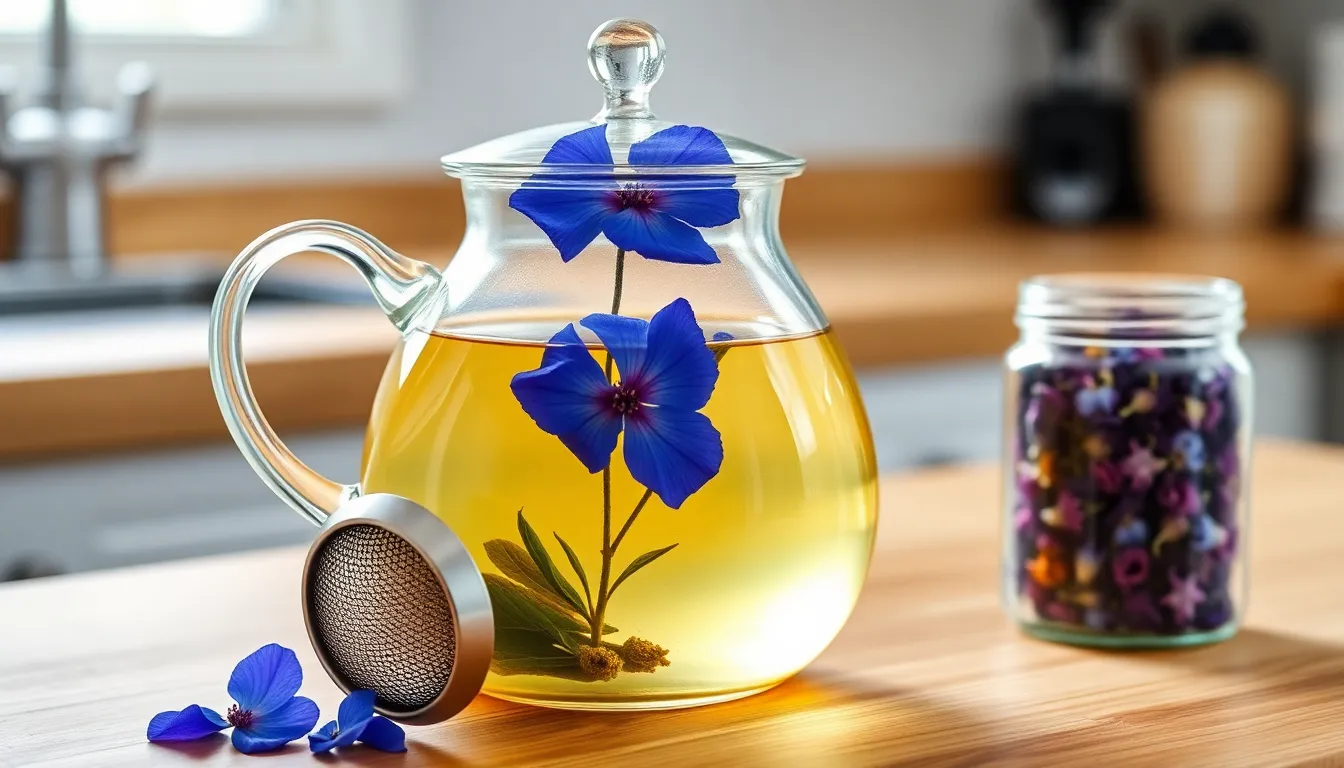
Brewing butterfly pea flower tea requires minimal equipment that most home cooks already have in their kitchen. We recommend gathering these essential tools before starting your tea preparation to ensure a smooth brewing process.
A teapot or tea infuser serves as the primary brewing vessel for hot preparation methods. Traditional teapots work perfectly for steeping the dried flowers while ceramic or glass infusers allow you to watch the beautiful blue color develop as the tea brews. Stainless steel infusers also work well and are easy to clean after use.
For cold brewing methods we suggest using a glass jar with a tight fitting lid. Mason jars work exceptionally well for this purpose because their wide mouths make it easy to add ingredients and strain the finished tea. The glass material allows you to observe the color transformation throughout the brewing process.
A teaspoon helps measure the proper amount of dried butterfly pea flowers for consistent results. Accurate measurement ensures the perfect balance of flavor and color intensity in every cup. We find that using the same measuring spoon each time creates reliable brewing results.
Fine mesh strainers remove the spent flowers from your finished tea whether you choose hot or cold brewing methods. Small handheld strainers work well for single servings while larger strainers handle bigger batches efficiently. Some tea enthusiasts prefer using cheesecloth or coffee filters for an ultra smooth final product.
Additional heat resistant glassware enhances the visual appeal of serving butterfly pea flower tea. Clear glasses or mugs showcase the stunning blue color and dramatic color changes when acidic ingredients are added. These vessels also help maintain the proper serving temperature for hot preparations.
Instructions
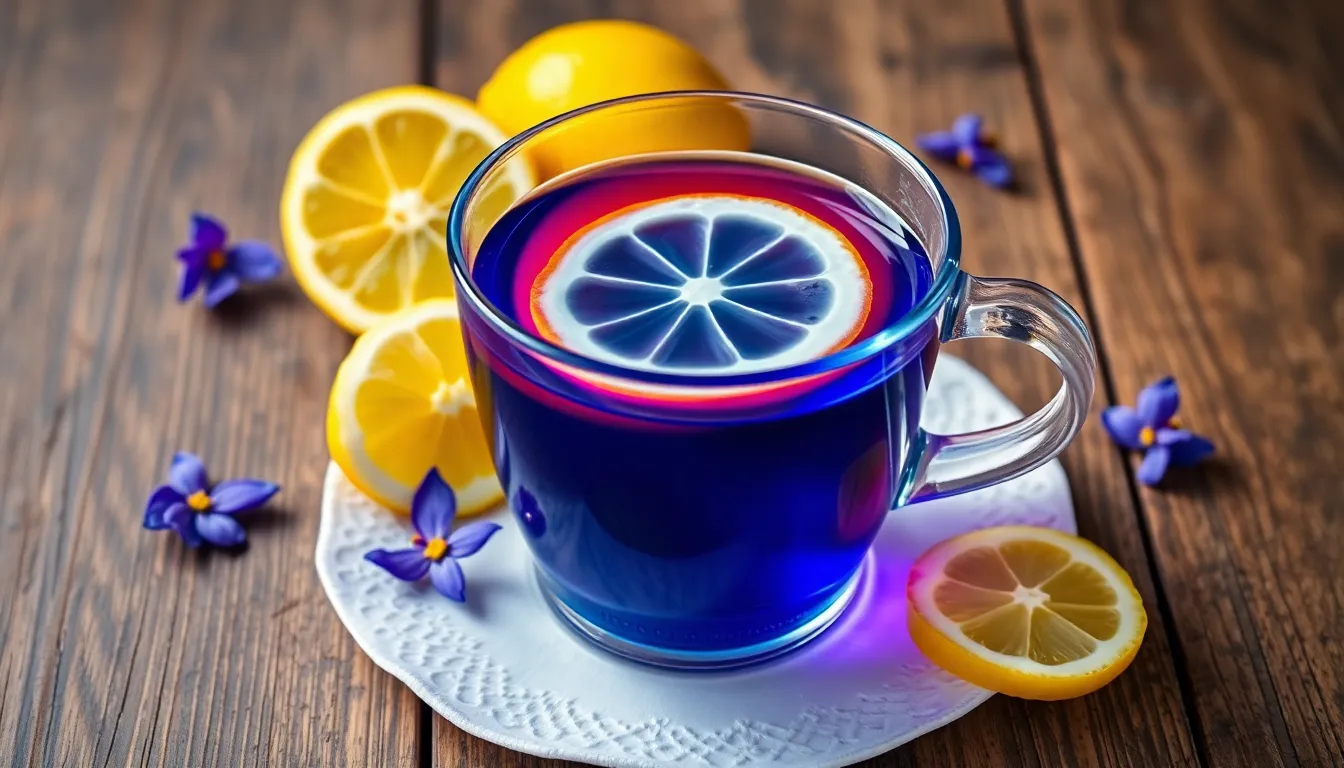
We’ll guide you through the simple process of brewing perfect butterfly pea flower tea that showcases its stunning color transformation properties. These steps ensure you extract maximum flavor and antioxidants from the dried flowers.
Prep
We start by rinsing 1 teaspoon of dried butterfly pea flowers under cold running water to remove any dust or impurities. This step ensures our tea maintains its pure, vibrant blue color without any unwanted particles. We recommend measuring the flowers carefully since using too many can create an overly strong, bitter taste that masks the tea’s naturally mild flavor profile.
Next, we prepare our brewing vessel by warming it with hot water, then discarding the water. This technique helps maintain optimal brewing temperature and prevents thermal shock to delicate glassware.
Brewing the Tea
We bring fresh water to a rolling boil, then let it cool for 30 seconds to reach the ideal temperature of around 200°F. Pouring the hot water directly over our prepared butterfly pea flowers creates the perfect extraction environment.
We steep the flowers for 5 to 7 minutes, adjusting the time based on our desired strength preference. During this steeping period, we watch as the water transforms into a brilliant blue color, indicating the release of beneficial anthocyanins and ternatins.
After steeping, we strain the tea through a fine mesh strainer to remove all spent flower petals. Our finished tea should display a clear, deep blue hue without any floating particles.
Adding Natural Flavor Enhancers
We enhance our butterfly pea flower tea with natural ingredients that complement its earthy flavor while preserving its color changing properties. Adding fresh lemon or lime juice creates an immediate transformation from blue to purple or pink, demonstrating the tea’s natural pH indicator abilities.
We sweeten our tea with honey or sugar without affecting its magical color properties. These natural sweeteners dissolve easily and balance the tea’s subtle grassy notes perfectly.
For additional flavor complexity, we incorporate fresh herbs like mint leaves, lemongrass stalks, or ginger slices during the steeping process. These herbs infuse their essence into the tea while adding complementary health benefits and aromatic qualities that enhance the overall drinking experience.
Serving Suggestions
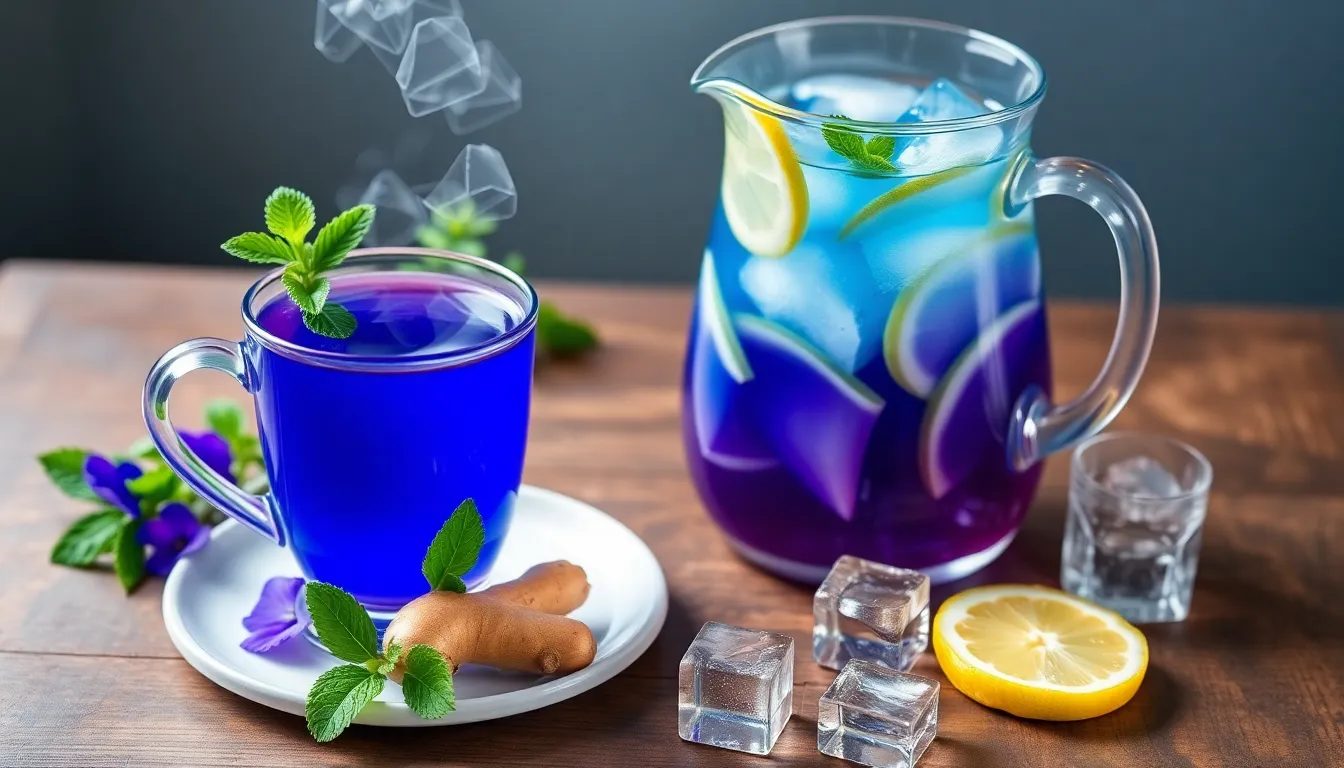
Butterfly pea flower tea offers incredible versatility in how we can enjoy this stunning beverage. Whether we prefer our tea steaming hot or refreshingly cold, this magical brew adapts beautifully to different serving styles while maintaining its visual appeal and health benefits.
Hot Butterfly Pea Flower Tea
We recommend steeping 1 cup of fresh or dried butterfly pea flowers in 1 liter of hot water that has been turned off just before boiling. The flowers should steep for 3-5 minutes to achieve the perfect balance of flavor and color intensity. After straining the flowers, we can serve the hot tea immediately with honey or sugar to taste.
Fresh herbs elevate the hot tea experience significantly. We often add mint or ginger during the steeping process to create complex flavor profiles that complement the tea’s natural earthiness. The warmth enhances the aromatic qualities of both the butterfly pea flowers and any additional herbs we choose to incorporate.
Iced Butterfly Pea Flower Tea
Cold butterfly pea flower tea requires a slightly different approach for optimal results. We start by preparing a concentrate using the hot steeping method, then strain the mixture thoroughly. Once cooled, we mix 1 part concentrate with 5 parts cold water to achieve the perfect strength.
Ice and fresh lemon juice transform this concentrate into a refreshing summer beverage. The cold preparation method allows us to store the concentrate in the refrigerator for up to a week, making it convenient for quick iced tea preparation throughout busy days.
Color-Changing Tea Variations
The most captivating aspect of butterfly pea flower tea lies in its dramatic color transformations based on pH levels. We can create stunning visual effects by strategically adding different ingredients to our prepared tea.
Acidic additions like lemon or lime juice instantly turn our blue tea into beautiful violet hues. This color change occurs due to the natural pH indicators in the butterfly pea flowers reacting with citric acid.
Basic additions such as hibiscus create an entirely different transformation, turning our tea bright red. This dramatic shift showcases the remarkable chemistry behind butterfly pea flowers.
Neutral state preserves the tea’s original brilliant blue color when we avoid adding acidic or basic ingredients. This pure blue appearance provides the perfect canvas for experimenting with different color variations throughout our tea service.
Storage Tips
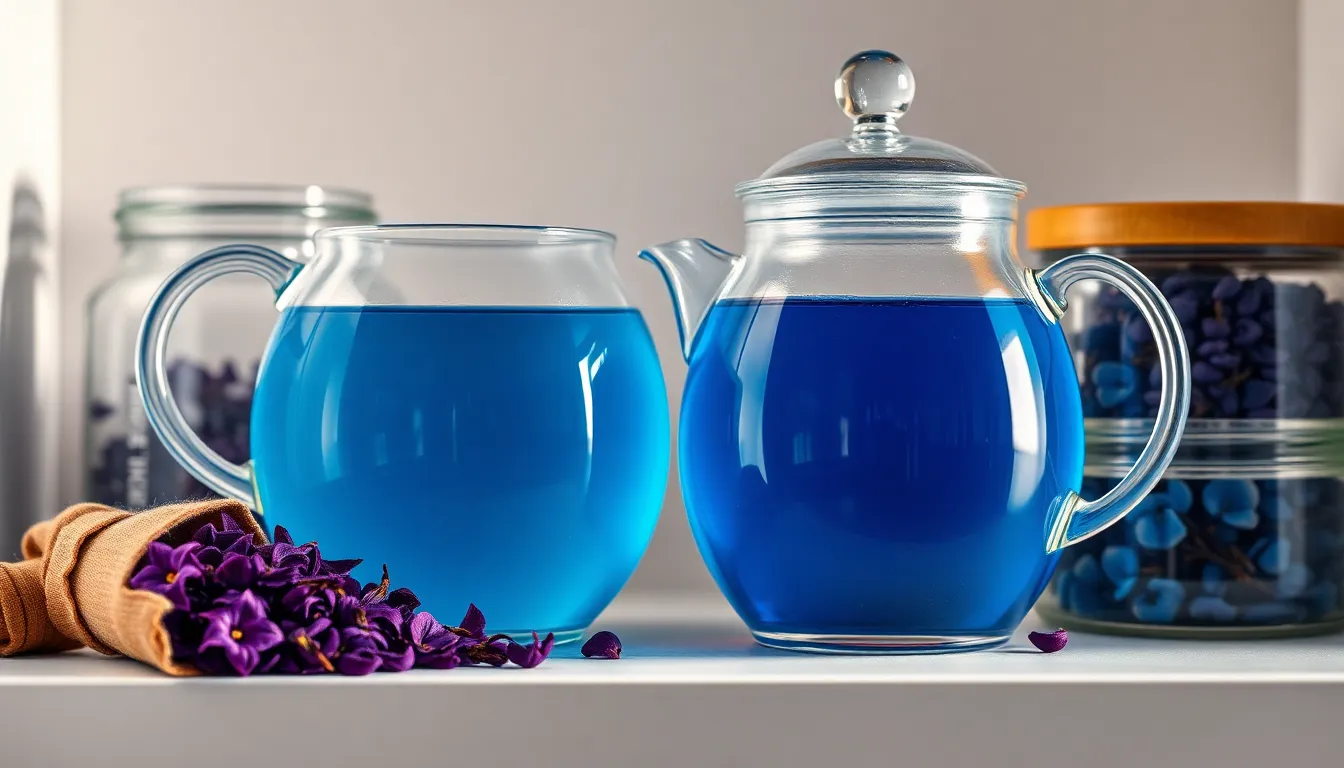
Proper storage ensures our butterfly pea flower tea maintains its vibrant color and potent health benefits for months. We recommend keeping dried butterfly pea flowers or tea bags in airtight containers to minimize oxygen exposure and preserve their distinctive blue pigments and antioxidant properties.
Keep It Cool and Dry
Our tea performs best when stored in cool and dry locations away from direct sunlight. Heat and moisture can degrade the delicate anthocyanins responsible for the tea’s signature color-changing magic. We suggest choosing storage spots that remain consistently cool and avoid areas near stoves or sunny windowsills.
Protect from Light and Odors
Light exposure gradually diminishes the tea’s quality and visual appeal over time. We store our butterfly pea flowers away from strong-smelling foods since the dried petals can absorb surrounding aromas. Pantry shelves or dedicated tea storage areas work exceptionally well for maintaining optimal conditions.
Refrigeration Guidelines
Brewed butterfly pea flower tea requires different storage considerations than dried flowers. We recommend refrigerating prepared tea in sealed containers where it maintains freshness for 2 to 3 days. Glass containers work particularly well for preserving both flavor and that stunning blue color we love.
Shelf Life Expectations
| Storage Method | Duration | Quality Retention |
|---|---|---|
| Dried flowers (proper storage) | Up to 24 months | Excellent color and antioxidants |
| Brewed tea (refrigerated) | 2-3 days | Fresh flavor and visual appeal |
| Tea bags (airtight) | 18-24 months | Maintained potency |
Properly stored dried butterfly pea flower tea typically maintains its quality for up to 24 months. We find that following these storage practices helps retain the tea’s unique properties and ensures every cup delivers that visually appealing and healthy beverage experience we expect from this remarkable flower.
Make-Ahead Instructions
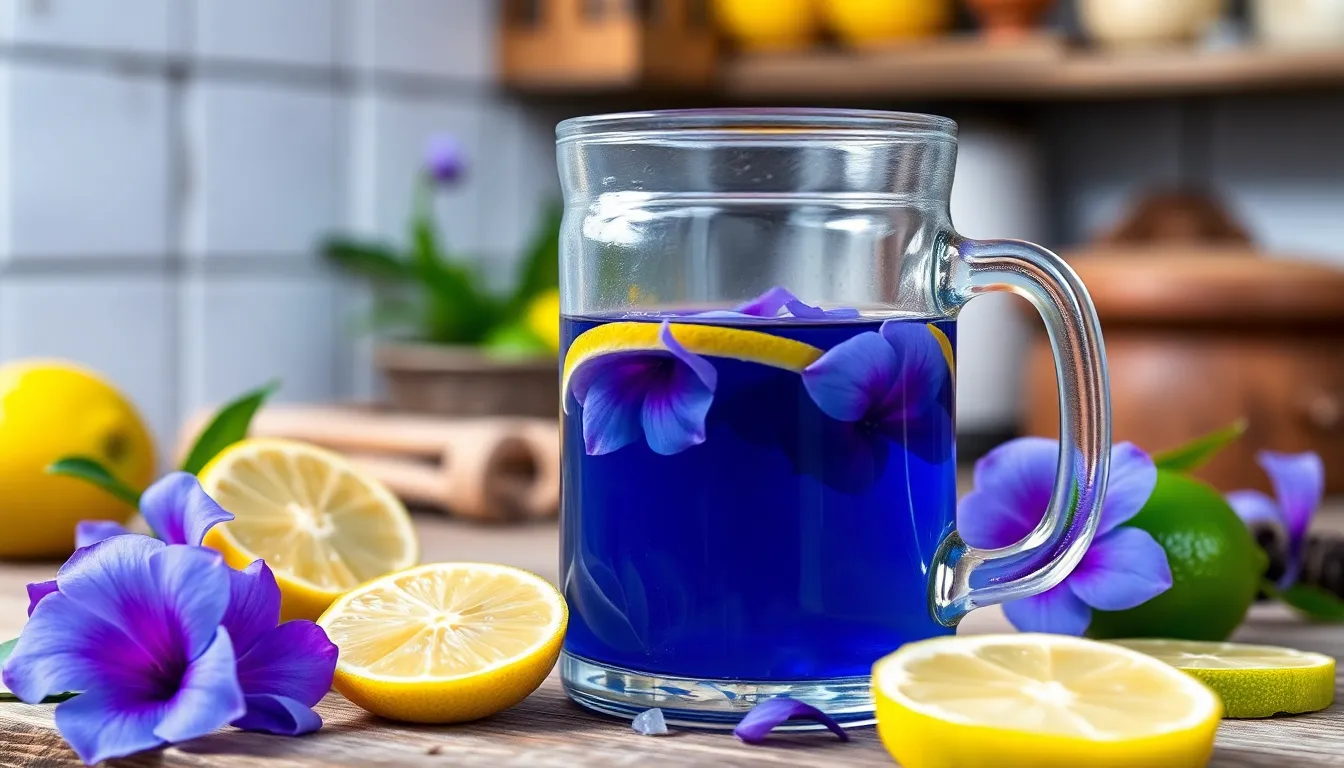
We can easily prepare butterfly pea flower tea concentrate in advance to save time during busy weekdays or when entertaining guests. Brewing the base tea ahead allows us to store the brilliant blue concentrate in our refrigerator for up to three days without losing its vibrant color or beneficial properties.
Preparing Tea Concentrate
Start by brewing a strong concentrate using double the amount of dried butterfly pea flowers we would normally use. Steep 2 tablespoons of dried flowers in 2 cups of hot water for 10 to 20 minutes depending on desired strength. The longer steeping time creates a more concentrated base that maintains its deep blue color even after dilution.
Storage Methods
Store the strained concentrate in airtight glass containers or mason jars in the refrigerator immediately after cooling to room temperature. Glass containers preserve the tea’s color better than plastic and prevent any unwanted flavors from seeping into our carefully prepared concentrate.
Make-Ahead Assembly Options
We can prepare individual serving portions by combining the concentrate with other ingredients just before serving. Mix equal parts concentrate with cold water or sparkling water for a refreshing drink. Add fresh lemon juice or lime juice at serving time to create the stunning color transformation from blue to purple or pink.
Batch Preparation Tips
For larger gatherings we recommend preparing butterfly pea lemonade or Nam Anchan Manow by mixing the concentrate with freshly squeezed citrus juice and sweetener of choice. These mixed beverages maintain their quality for up to 24 hours when stored properly in sealed containers.
The make-ahead approach ensures we always have this magical tea ready to impress guests while maximizing the convenience of this naturally caffeine-free beverage.
Troubleshooting Common Issues
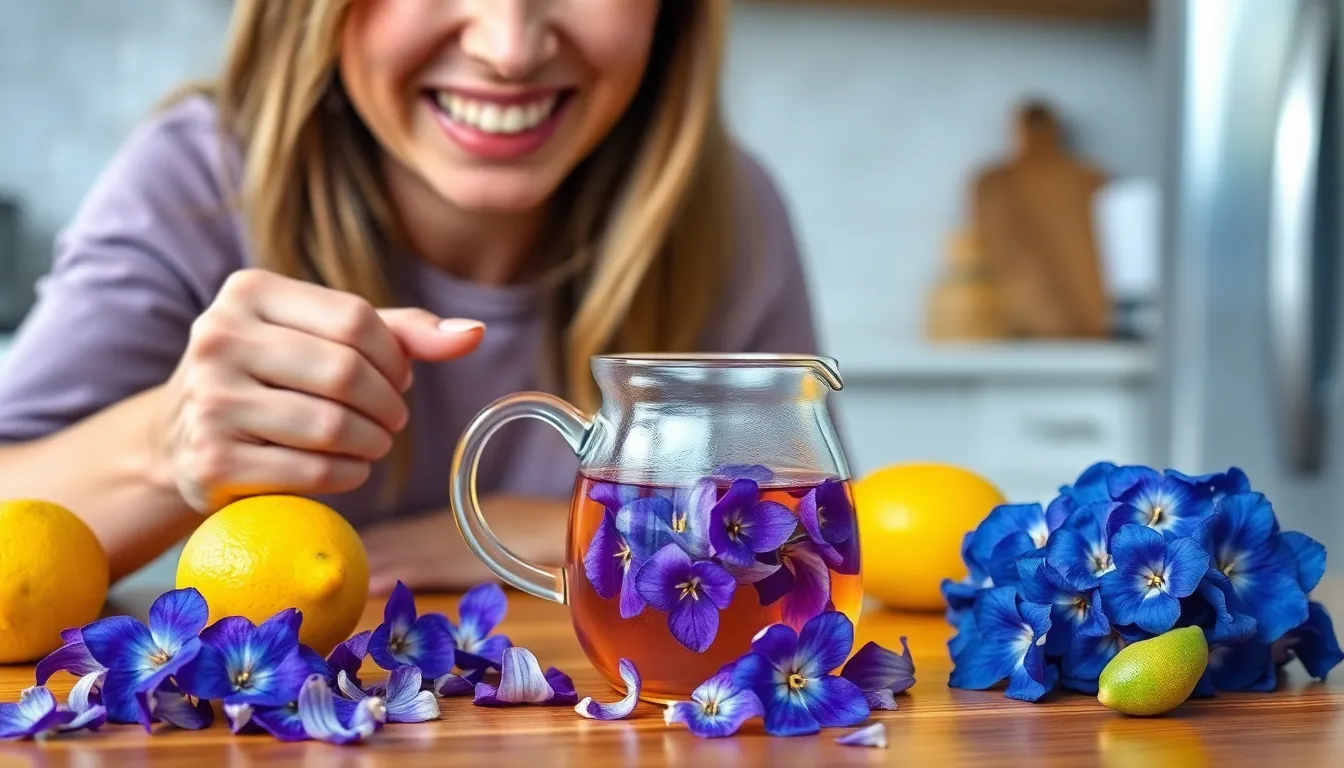
Even experienced tea brewers encounter challenges when preparing butterfly pea flower tea. We’ve compiled answers to the most common problems to help you achieve perfect results every time.
Weak or Pale Blue Color
When your tea appears light blue or lacks the vibrant color you expect, several factors could be at play. We recommend increasing the steeping time to 7-10 minutes rather than the standard 5 minutes. Using more dried flowers also intensifies the color – try 2 teaspoons per cup instead of 1 teaspoon. Water temperature plays a crucial role as well. Make sure your water reaches a full boil before pouring over the flowers.
Old or improperly stored flowers lose their potency over time. Check that your dried butterfly pea flowers maintain their deep blue color and haven’t faded to purple or brown. Fresh flowers should feel crisp and release a subtle floral aroma when crushed gently between your fingers.
Bitter or Unpleasant Taste
Oversteeping causes bitterness in butterfly pea flower tea just like any other herbal brew. We suggest limiting steeping time to 7 minutes maximum for hot preparations. Using too many flowers creates an overly concentrated and bitter result. Stick to our recommended ratio of 1-2 teaspoons per cup of water.
Water quality significantly affects taste. Hard water with high mineral content can create metallic or harsh flavors. Use filtered or spring water for the best results. Adding a pinch of salt to hard water before boiling can help neutralize some minerals.
Color Won’t Change with Lemon
The magical color transformation relies on the tea’s pH level. Fresh lemon or lime juice works better than bottled varieties for creating the purple-pink shift. We recommend using at least 1/2 teaspoon of fresh citrus juice per cup of tea. If the color remains stubbornly blue, try adding small amounts gradually until you see the change begin.
Temperature affects the color change reaction. Hot tea typically shows more dramatic color shifts than cold preparations. For iced tea, add the lemon juice to the concentrate while it’s still warm, then chill the mixture.
Cloudy or Murky Appearance
Proper straining prevents cloudiness in your finished tea. We use fine mesh strainers or cheesecloth to remove all flower particles after steeping. Double straining through progressively finer filters creates crystal clear results.
Rushing the cooling process can cause cloudiness in iced preparations. Allow hot tea to reach room temperature naturally before refrigerating. Sudden temperature changes create condensation that clouds the liquid.
Flowers Floating or Not Steeping Properly
Dried butterfly pea flowers naturally float due to their light weight. We recommend covering the steeping vessel with a lid or heat-proof plate to trap steam and encourage proper extraction. Gently stirring the flowers once during steeping helps release more color and flavor compounds.
Using a tea infuser or strainer basket keeps flowers contained while allowing proper water circulation. For loose steeping, we suggest pressing the flowers down gently with a spoon after the first minute of steeping.
Loss of Potency Over Time
Exposure to light and air degrades the anthocyanins responsible for butterfly pea tea’s color and health benefits. Store dried flowers in opaque, airtight containers away from heat sources. Glass jars work well when kept in dark pantries or cabinets.
Grinding flowers into powder increases surface area and accelerates degradation. We recommend keeping flowers whole until ready to use. Check stored flowers every few months for color retention and replace them if they’ve lost their vibrant blue hue.
Inconsistent Results Between Batches
Different suppliers may offer varying quality levels of butterfly pea flowers. We suggest purchasing from reputable sources that provide harvest dates and storage information. Flowers from the same supplier can vary seasonally, so adjust your measurements accordingly when switching to new batches.
Keep detailed notes about your brewing ratios, steeping times, and water sources. This documentation helps identify variables that affect your results and allows you to replicate successful batches consistently.
Creative Variations and Recipes
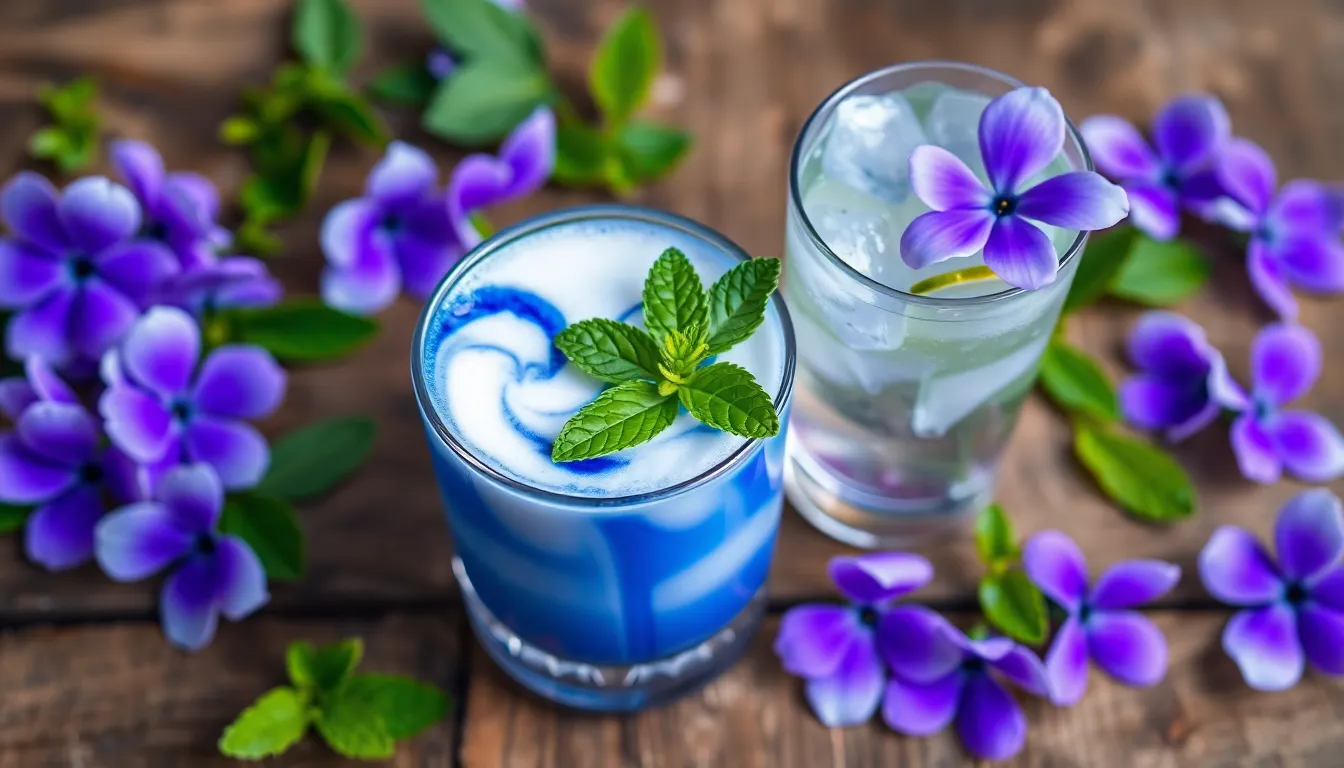
Beyond the traditional tea preparation, butterfly pea flowers offer endless possibilities for creative beverages that showcase their stunning color-changing properties. We can transform this versatile ingredient into elegant lattes, refreshing cocktails, and vibrant lemonades that delight both the eyes and palate.
Butterfly Pea Flower Latte
Creating a butterfly pea flower latte elevates this traditional tea into a creamy, Instagram-worthy beverage perfect for any time of day. We recommend brewing a strong tea base using 8-14 dried flowers or ¼-½ teaspoon of butterfly pea powder steeped in hot water for 5-7 minutes.
Ingredients:
- 8-14 dried butterfly pea flowers (or ¼-½ tsp powder)
- 1 cup hot water
- ½ cup milk of choice (dairy, almond, oat, or coconut)
- 1-2 tablespoons condensed milk or preferred sweetener
- Ice cubes (for iced version)
Steam or heat your milk until frothy and warm. Pour the brewed butterfly pea tea into your serving cup and slowly add the steamed milk, creating beautiful blue and white swirls. Sweeten with condensed milk for authentic Asian cafe flavor, or use honey for a lighter touch. For an iced latte, brew the tea stronger and pour it over ice before adding cold milk and sweetener.
Butterfly Pea Flower Cocktails
Butterfly pea flower tea creates spectacular cocktails and mocktails that transform before your guests’ eyes. The tea’s pH-reactive properties make every drink a visual masterpiece when citrus is added.
Butterfly Pea Mojito (Mocktail):
- 1 cup cooled butterfly pea tea
- 8-10 fresh mint leaves
- 2 tablespoons lime juice
- 1 tablespoon sugar syrup
- Soda water
- Crushed ice
Muddle mint leaves gently in the bottom of your glass to release their oils. Add lime juice and sugar syrup, then pour in the butterfly pea tea and watch it transform from blue to purple. Top with soda water and crushed ice for a refreshing mocktail that changes color with each sip.
The acidic lime juice creates a dramatic color shift from cobalt blue to vibrant purple or pink, making this drink perfect for parties and special occasions. We can create similar effects with other citrus fruits or even hibiscus tea for additional color variations.
Butterfly Pea Flower Lemonade
This stunning lemonade combines the visual drama of butterfly pea tea with the refreshing taste of classic lemonade. The color transformation from blue to purple creates an enchanting drink that tastes as good as it looks.
Ingredients:
- 2 cups cooled butterfly pea tea (brewed from 10-12 flowers)
- ¼ cup fresh lemon or lime juice
- 2 tablespoons elderflower syrup or sugar to taste
- 2 cups sparkling water or club soda
- Ice cubes
- Lemon slices for garnish
Brew your butterfly pea tea and allow it to cool completely in the refrigerator. In a large pitcher, combine the cooled tea with elderflower syrup or sugar, stirring until dissolved. Add sparkling water for effervescence and serve over ice in clear glasses to showcase the beautiful blue color.
| Recipe Component | Traditional Tea | Latte | Lemonade |
|---|---|---|---|
| Steeping Time | 3-5 minutes | 5-7 minutes | 3-5 minutes |
| Flower Count | 5-6 flowers | 8-14 flowers | 10-12 flowers |
| Serving Temperature | Hot or Cold | Hot or Iced | Cold |
Pour lemon juice into each glass just before serving and watch the magical transformation unfold as the blue liquid turns purple and pink. This creates layers of color that make every sip a visual treat while delivering the refreshing taste of premium lemonade.
Where to Buy Butterfly Pea Flowers
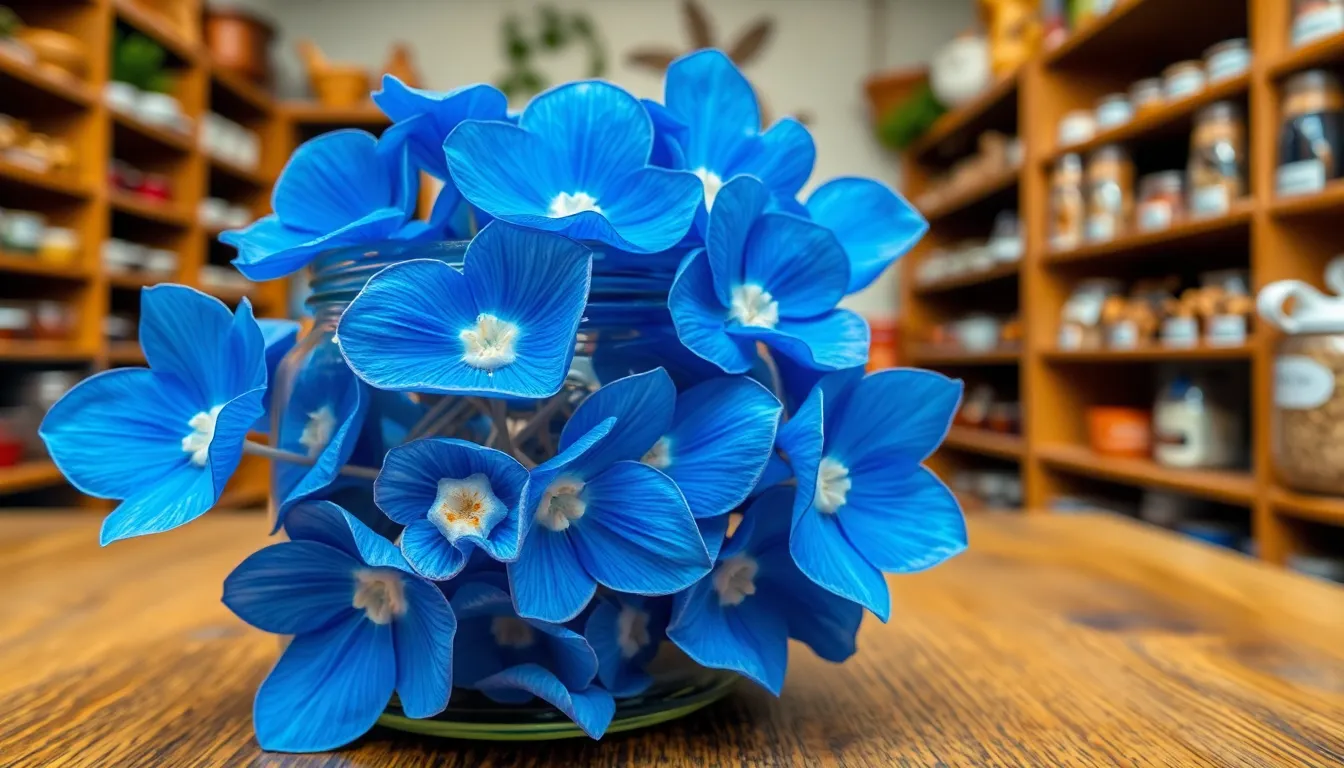
Finding high-quality dried butterfly pea flowers has become easier as their popularity continues to grow among health-conscious tea enthusiasts. We recommend starting your search at local health food stores, which often carry organic dried butterfly pea flowers in their herbal tea sections. Many specialty tea shops now stock these vibrant blue flowers, allowing you to examine the quality before purchasing.
Online marketplaces like Amazon offer the widest selection of butterfly pea flower products, including loose dried flowers, tea bags, and herbal tea blends. These platforms provide customer reviews and detailed product descriptions that help ensure you’re getting authentic Clitoria ternatea flowers. We suggest reading customer feedback carefully to verify the color intensity and freshness of the products.
Specialty tea retailers and Asian grocery stores frequently stock butterfly pea flowers, particularly those focusing on Southeast Asian ingredients. These establishments often source directly from regions where the flowers are native, ensuring authenticity and potency. Local farmers markets occasionally feature vendors selling dried butterfly pea flowers, especially in areas with diverse agricultural communities.
| Purchase Location | Typical Price Range | Quality Indicators |
|---|---|---|
| Health Food Stores | $12-18 per 2 oz | Organic certification, visible deep blue color |
| Online Marketplaces | $8-25 per package | Customer reviews, seller ratings |
| Specialty Tea Shops | $15-22 per 2 oz | Expert guidance, premium sourcing |
| Asian Grocery Stores | $6-12 per package | Traditional sourcing, bulk options |
When selecting butterfly pea flowers, we prioritize products that display deep blue coloration and minimal stem or leaf content. Quality flowers should feel dry and crisp to the touch, with no signs of moisture or mold. Packaging should be airtight and opaque to protect the delicate anthocyanins that give the flowers their distinctive color and health benefits.
We recommend purchasing from suppliers who provide information about the harvest date and origin of their butterfly pea flowers. Products sourced from Thailand, Malaysia, or other Southeast Asian countries where Clitoria ternatea grows naturally often offer superior quality and potency. Organic certification adds another layer of quality assurance, ensuring the flowers are free from pesticides and chemicals.
Bulk purchases can offer important savings for regular butterfly pea tea drinkers, but we suggest starting with smaller quantities to test quality and personal preference. Many online retailers offer sample sizes or starter packs that allow you to evaluate different suppliers before committing to larger orders.
Conclusion
We’ve discovered that butterfly pea flower tea offers much more than its stunning visual appeal. This remarkable beverage combines traditional wisdom with modern health benefits making it an excellent addition to our daily wellness routine.
From its antioxidant-rich properties to its caffeine-free nature butterfly pea flower tea provides a versatile foundation for countless creative preparations. Whether we’re brewing a simple hot cup or crafting elaborate color-changing cocktails this Southeast Asian treasure adapts beautifully to our preferences.
The accessibility of high-quality dried flowers through various retailers means we can easily incorporate this beneficial tea into our lives. With proper storage techniques and brewing methods we’ll consistently enjoy the full spectrum of flavors and health benefits this extraordinary flower offers.
Now it’s time to experience the magic ourselves and discover why butterfly pea flower tea has captivated tea enthusiasts worldwide.
Frequently Asked Questions
What is butterfly pea flower tea?
Butterfly pea flower tea is a vibrant blue, caffeine-free herbal beverage made from the dried petals of Clitoria ternatea, a flower native to Southeast Asia. Known for its unique color-changing properties, the tea transforms from blue to purple or pink when acidic ingredients like lemon are added. It has a mild, earthy flavor and is rich in antioxidants.
How do you make butterfly pea flower tea?
To make butterfly pea flower tea, steep 1-2 teaspoons of dried butterfly pea flowers in 8 ounces of hot water (195-205°F) for 5-7 minutes. Strain the flowers and enjoy the brilliant blue tea. Add lemon juice to create a stunning color transformation from blue to purple or pink. Sweeten with honey if desired.
What are the health benefits of butterfly pea flower tea?
Butterfly pea flower tea offers numerous health benefits including high antioxidant content, anti-inflammatory properties, potential cognitive support, eye health improvement, blood sugar management assistance, and immune system boosting. The tea contains beneficial compounds like anthocyanins, ternatins, and kaempferol that contribute to these health-promoting effects.
Why does butterfly pea flower tea change color?
The color change occurs due to natural anthocyanins in the butterfly pea flowers, which act as pH indicators. When acidic ingredients like lemon, lime, or vinegar are added to the blue tea, the pH changes, causing the anthocyanins to shift the color from blue to purple or pink. This creates a visually stunning transformation.
Where can I buy butterfly pea flowers?
You can purchase dried butterfly pea flowers at local health food stores, specialty tea shops, Asian grocery stores, and online marketplaces like Amazon. Look for deep blue coloration with minimal stems or leaves. Organic certification and information about harvest date and origin indicate higher quality products.
How should I store butterfly pea flower tea?
Store dried butterfly pea flowers in airtight containers in cool, dry locations away from direct sunlight to preserve their blue pigments and antioxidant properties. Properly stored dried flowers last up to 24 months, while tea bags maintain potency for 18-24 months. Brewed tea should be refrigerated and consumed within 2-3 days.
Is butterfly pea flower tea safe to drink?
Yes, butterfly pea flower tea is generally safe for most people when consumed in moderate amounts. It’s naturally caffeine-free and has been used in traditional medicine for centuries. However, pregnant or breastfeeding women and people with specific medical conditions should consult their healthcare provider before regular consumption.
Can I drink butterfly pea flower tea cold?
Absolutely! Butterfly pea flower tea is excellent both hot and cold. For iced tea, prepare a concentrate by steeping with double the amount of flowers, then mix with cold water and ice. The cold version maintains the same beautiful color and health benefits while providing a refreshing beverage option.

